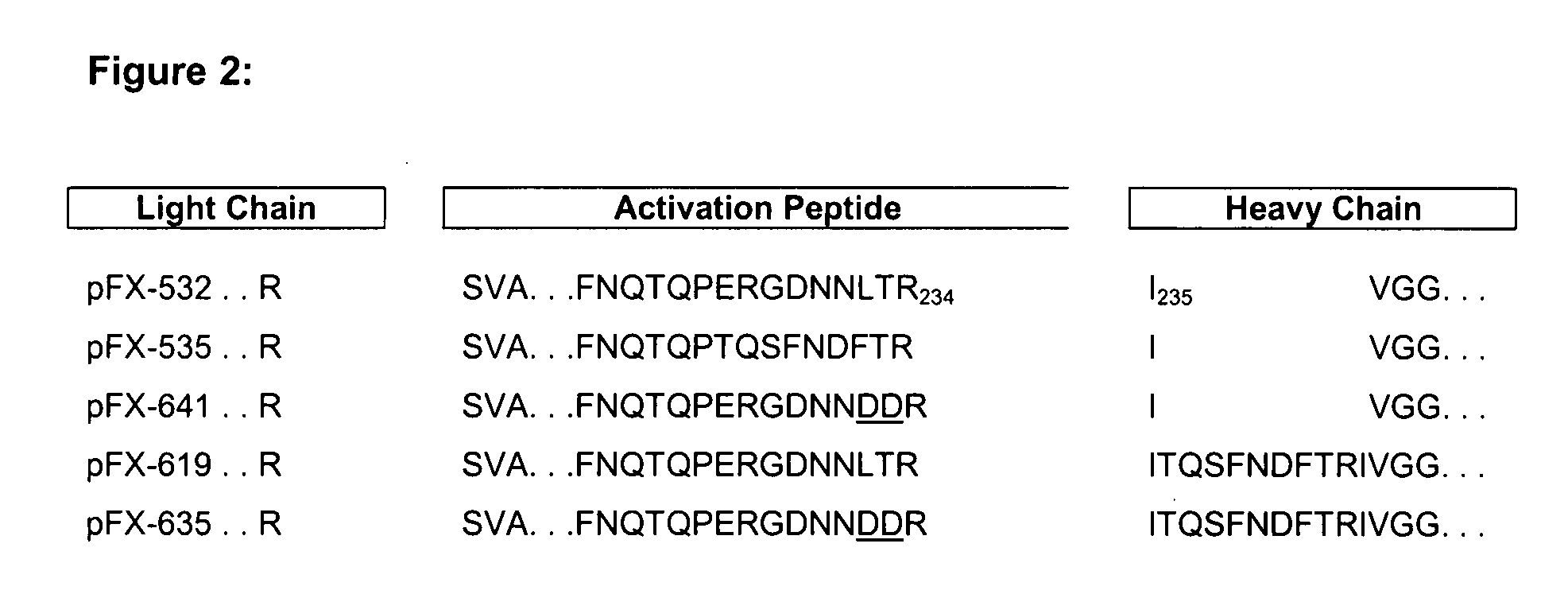Coagulation factor x polypeptides with modified activation properties
a polypeptide and activation property technology, applied in the field of coagulation factor x polypeptides with modified activation properties, can solve the problems of thrombosis risk, high cost, and invasive therapy, and achieve the effect of reducing the risk of thrombosis and reducing the risk of coagulation factor x variants
- Summary
- Abstract
- Description
- Claims
- Application Information
AI Technical Summary
Problems solved by technology
Method used
Image
Examples
example 1
Construction of Expression Plasmids
[0071]Factor X coding sequence was amplified by PCR from a human liver cDNA library (Ambion) using primers We1292 and We1293 (SEQ ID NO 3 and 4). In a second round of PCR using primers We1354 and We 1355 (SEQ ID NO 5 and 6) a cleavage site for restriction endonuclease NheI was introduced to the 5′-end and a cleavage site for restriction endonuclease NotI was introduced to the 3′-end of the fragment. The PCR fragment was then inserted into the NheI / NotI sites of pIRESpuro3 (BD Biosciences). The resulting plasmid was designated pFX-445.
[0072]To improve processing of the propeptide the cleavage site was improved by replacing amino acid threonine at position 39 (SEQ ID NO 2) by arginine (Rudolph et al., 1997 (Protein Expression and Purification 10:373-378)). For that, pFX-445 was subjected to site-directed mutagenesis using oligonucleotides We1482 and We 1483 (SEQ ID NO 7 and 8) according to standard methods (QuickChange XL Site Directed Mutagenesis Ki...
example 2
Transfection and Expression of Modified Factor X Molecules
[0076]Plasmids were grown up in E. coli TOP10 (Invitrogen) and purified using standard protocols (Qiagen). HEK 293 cells were transfected using the Lipofectamine 2000 reagent (Invitrogen) and grown up in serum-free medium (Invitrogen 293 Express) in the presence of 50 ng / ml Vitamin K and 4 μg / ml Puromycin. About four weeks post transfection supernatants were harvested for biochemical characterization.
example 3
Characterization of Recombinant Factor X Variants
[0077]The expression of the factor X variants was controlled by quantitative ELISA using monoclonal antibodies against factor X. Integrity of the recombinant proteins was analysed subsequently by SDS-PAGE and Western blotting. Samples were analysed under reduced and non-reduced conditions. Plasmatic factor X served as a native molecular weight control, factor Xa was used to detect and compare any activated recombinant factor X variants in case of auto-activation. As visualized in Western blots, all recombinant factor X variants were expressed with the correct molecular weight of about 58 kDa, and migrated at a comparable position to plasmatic factor X. When reduced, the recombinant factor X variants disintegrated into a heavy chain (HC) of approximately 40 kDa and a light chain (LC) of approximately 20 kDa. The 58 kDa band represented unprocessed one-chain (OC) factor X. There was neither factor Xa nor any aggregates of factor X detec...
PUM
| Property | Measurement | Unit |
|---|---|---|
| molecular weight | aaaaa | aaaaa |
| nucleic acid | aaaaa | aaaaa |
| blood coagulation disorder | aaaaa | aaaaa |
Abstract
Description
Claims
Application Information
 Login to View More
Login to View More - R&D
- Intellectual Property
- Life Sciences
- Materials
- Tech Scout
- Unparalleled Data Quality
- Higher Quality Content
- 60% Fewer Hallucinations
Browse by: Latest US Patents, China's latest patents, Technical Efficacy Thesaurus, Application Domain, Technology Topic, Popular Technical Reports.
© 2025 PatSnap. All rights reserved.Legal|Privacy policy|Modern Slavery Act Transparency Statement|Sitemap|About US| Contact US: help@patsnap.com



